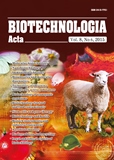ISSN 2410-7751 (Печатная версия)
ISSN 2410-776X (Электронная версия)

"Biotechnologia Acta" V. 8, No 6, 2015
https://doi.org./10.15407/biotech8.06.023
Р. 23-31, Bibliography 17, English
Universal Decimal Classification: 759.873.088.5:661.185
T. P. Pirog1,2, T. A. Shevchuk1, K. A. Beregova2, N. B. Kudriya2
1Zabolotny Institute of Microbiology and Virology of the National Academy of Sciences of Ukraine, Kiev
2Natsional University of Food Technologies, Kiev
The purpose of this study was to establish optimal molar glycerol to glucose ratio for enhanced biosurfactant synthesis by the cultivation of Nocardia vacсinii MV В-7405 on a mixture of energetically nonequivalent substrates (glucose and glycerol).
Based on theoretical calculations of the energy requirements for biomass production and the synthesis of surface-active trehalose monomycolates on the energy-deficient substrate (glycerol), the concentration of the energy-excessive substrate (glucose), which increased the efficiency of the substrate carbon conversion to biosurfactant, was determined. It was found that the synthesis of extracellular biosurfactant on a mixture of glucose and glycerol at molar ratio of 1.0:2.5 increased 2.0–2.3-fold ompared to that on corresponding monosubstrates.
The increased level of biosurfactant on the mixed substrate is determined by intensification of surface-active trehalose monomycolate synthesis, confirmed by 1.2-5.7–fold increase in activity of the enzymes involved in their biosynthesis (trehalose phosphate synthase, phosphoenolpyruvatecarboxykinase, phosphoenolpyruvate-synthetase) compared to cultivation on monosubstrates glucose and glycerol. The results indicate the feasibility of using a mixture of energetically nonequivalent substrates for enhancing the synthesis of secondary metabolites, as well as possibility of achieving the high efficiency of these mixed substrates if they are properly chosen and the molar ratio of their concentrations are correctly determined.
Key words: Nocardia vacсinii IМВ В-7405, biosurfactant, energetically nonequivalent substrates.
© Palladin Institute of Biochemistry of the National Academy of Sciences of Ukraine, 2015
References
1. Pirog T. P., Kovalenko M. A., Kuz’minskaya Yu. V. Intensification of exopolysaccharide synthesis by Acinetobacter sp. on an ethanol–glucose mixture: aspects related to biochemistry and bioenergetics. Microbiology. 2003, 72 (3), 305–312.
2. Pidhorskyy V., Iutinska G., Pirog T. Intensification of microbial synthesis technologies. Кyiv: Nauk. dumka. 2010, 327 p. (In Ukrainian).
3. Pirog T. P., Konon A. D., Shevchuk T. A., Bilets I. V. Intensification of biosurfactant synthesis by Acinetobacter calcoaceticus IMV B-7241 on a hexadecane–glycerol mixture. Microbiology. 2012, 81 (5), 565–572.
4. Pirog T. P., Shulyakova M. A., Shevchuk T. A. Mixed substrates in environment and biotechnological processes. Biotechnol. acta. 2013, 6 (6), 28?44. (In Ukrainian).
5. Kudrya N., Pirog T. The specifics of surfactants synthesis during Nocardia vaccinii ІMV B-7405 cultivation on mixed substrates. Ukrainian food journal. 2013, 2 (2), 203?209. (In Ukrainian).
6. Pirog T., Shevchuk T., Beregova K., Kudrya N. Peculiarities of glucose and glycerol metabolism in Nocardia vaccinii ІМВ В-7405 ? producer of biosurfactants. Ukr. Biochem. J. 2015, 87 (2), 66?75. (In Ukrainian).
7. Bligh E. G., Dyer W. J. A rapid method for total lipid extraction and purification. Can. J. Biochem. Physiol. 1959, 37 (8), 911?917.
8. Bradford M. A rapid sensitive method for the quantitation of microgram quantities of protein utilizing the principle of protein-dye binding. Anal. Biochem. 1976, 72 (3), 248–254.
9. Babel W. Bewertung von substraten fur das mikrobielle wachstum auf der grundlage ihres kohlenstoff/energie-verhaltnisses. Z. Allg. Mikrobiol. 1979, 19 (9), 671?677.
10. Babel W., Muller R. H. Mixed substrate utilization in microorganisms: Biochemical aspects and energetic. J. Gen. Microbiol. 1985, 131 (1), 39?45.
11. Pirog T., Gritsenko N., Khomyak D., Konon A., Antonuk S. Optimization of synthesis of biosurfactants of Nocardia vaccinii K-8 under bioconversion of biodiesel production waste. Microbiol. Zh. 2011, 73 (4), 15?24. (In Russian).
12. Rosenberg E., Ron E.Z. High- and low-molecular-mass microbial surfactants. Appl. Microbiol. Biotechnol. 1999, 52 (2), 154–162. http://dx.doi.org/10.1007/s002530051502
13. Jin P., Lu S., Huang H., Luo F., Li S. Enhanced reducing equivalent generation for 1,3-propanediol production through cofermentation of glycerol and xylose by Klebsiella pneumonia. Appl. Biochem. Biotechnol. 2011, 165 (7–8), 1532–1542. http://dx.doi.org/10.1007/s12010-011-9373-1
14. Workman M., Holt P., Thykaer J. Comparing cellular performance of Yarrowia lipolytica during growth on glucose and glycerol in submerged cultivations. AMB Express. 2013, 3:58. doi: 10.1186/2191-0855-3-58.
15. Wadekar S. D., Kale S. B., Lali A. M., Bhowmick D. N., Pratap A. P. Utilization of sweetwater as a cost-effective carbon source for sophorolipids production by Starmerella bombicola (ATCC 22214). Prep. Biochem. Biotechnol. 2012, 42 (2), 125?142. doi: 10.1080/10826068.2011.577883.
16. Poomtien J., Thaniyavarn J., Pinphanichakarn P., Jindamorakot S., Morikawa M. Production and characterization of a biosurfactant from Cyberlindnera samutprakarnensis JP52T. Biosci. Biotechnol. Biochem. 2013, 77 (12), 2362–2370. http://dx.doi.org/10.1271/bbb.130434
17. Sari M., Kanti A., Artika I. M., Kusharyoto W. Identification of Pseudozyma hubeiensis Y10BS025 as a potent producer of glycolipid biosurfactant mannosylerythritol lipids. Amer. J. Biochem. Biotechnol. 2013, 9 (4), 430–437. http://dx.doi.org/10.3844/ajbbsp.2013.430.437

